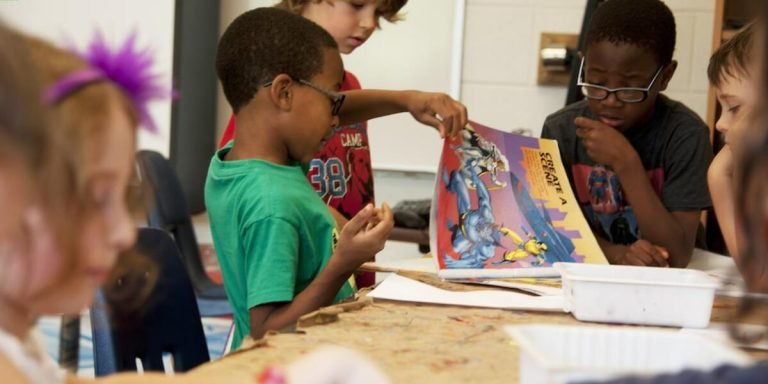Literacy Strategies for Reading: A Comprehensive Guide for Parents and Educators
Understanding how to apply effective literacy strategies for reading can significantly influence a child’s academic journey. In the elementary school learning phase, these teaching techniques are not just essential for developing their ability to read but also in shaping their comprehension and critical thinking skills.
This comprehensive guide is designed as an invaluable resource both for parents and educators alike. It focuses on enlightening you with various proven methods that can facilitate successful reading habits among youngsters, thereby setting up a strong foundation for future learning endeavors.
Did you know?
Did you know? Children who are read to at home have a higher success rate in learning to read. In fact, according to the National Center for Education Statistics (NCES), children introduced to reading before preschool are three times more likely to succeed in later education levels.
Integrating Literacy Strategies into Elementary Reading Curricula
As educators, we find ourselves in an era where technology has permeated every aspect of our lives, and the classroom is no exception. Integrating literacy strategies into elementary reading curricula can be a transformative step towards enhancing learning outcomes for young students. A crucial part of this approach involves incorporating digital tools that align with said strategies to further enrich the learning experience.
Digital literacy platforms offer interactive activities tailored to developing different skillsets such as decoding words, identifying sounds or boosts comprehension abilities through engaging audio-visual content. These sophisticated educational technologies provide personalized experiences which adapt according to each child’s individual pace and level of understanding – one size doesn’t fit all here!
Let us also discuss about e-books; they are not just digitized versions of printed books but dynamically enhance children’s interaction with text. Children have been observed showing higher engagement levels when reading from these ‘smart’ ebooks due their ability offering instantaneous definitions for tough vocabulary words or pronunciations at touch! This degree integration helps break down barriers faced by slower readers while ensuring those who already excel continue face challenging material thereby catering both ends spectrum simultaneously.
The blending traditional literacy instruction important considerations like alphabetic principle phonemic awareness richly layered tech driven methods romance between old new offers promising landscape future elementary education marking shift how technology perceived supplementary tool integral component modern day classrooms leading better equipped more enthusiastic generation learners ready tackle challenges might come way during academic journey beyond Remember fostering love early age lays foundation successful life-long habit something cannot overemphasize upon enough.
Utilizing Phonics and Decoding in the Classroom
As part of a well-rounded reading curriculum in elementary schools, literacy strategies play a key role. One effective method involves the use of phonics and decoding strategies within classroom activities. Using ‘literacy strategies for reading’ can dramatically improve comprehension skills among young learners.
Phonics, a teaching technique that connects sounds with letters or groups of letters,’ serves as an essential tool to enable students to decode words independently. Good phonics instruction is multisensorial and engaging; it uses visual aids, manipulatives, movement and song to reinforce learning.
Decoding is equally critical in early childhood education because it allows children to recognize words quickly and efficiently while developing their fluency skills. It gives them tools they need not only read but also understand what’s being read by sounding out unknown words.
For instance, there are numerous online platforms available today featuring games focused on enhancing phonic recognition abilities that also make decoding exercises fun experience! These digital resources provide vibrant illustrations alongside audio prompts which support multi-sensory engagement – aiding retention making lessons more enjoyable too!
Implementing Guided Reading Sessions for Varied Skill Levels
Guided reading sessions can be an incredible asset to elementary school learning. As we navigate in 2023, it is vital to implement literacy strategies for varied skill levels during these sessions. These tailored approaches enhance students’ reading comprehension and cultivate a love of literature from a young age.
One effective literacy strategy for reading involves integrating technology into the curriculum. Kids tend to gravitate naturally towards technology; hence incorporating digital tools such as tablets or interactive e-books can make guided reading more engaging for them.
At one end, apps like Epic! offer access to thousands of children’s books catering all different ages and skill levels. This allows educators to assign specific eBooks based on individual student’s ability thus varying their guided readings appropriately while keeping track of their progress too.
On another note, audiobooks also prove beneficial by offering a multisensory experience that combines listening with following along visually – aiding particularly those who are auditory learners or struggling readers.
Understandably not every child learns at the same pace – some may require additional support through this journey which can easily be availed using personalized online tutoring platforms designed specifically working around targeted problem areas in real time during remote classes when necessary.
Enhancing Student Engagement Through Interactive Reading Activities
In the realm of literacy strategies for reading, interactive reading activities stand as an unsurpassed tool to facilitate student engagement and comprehension. With technology’s role in education being more prevalent than ever before in 2023, integrating it into these activities can exponentially augment their effectiveness.
Interactive reading is no longer a simple matter of opening a book or listening to a story; with the help of modern educational tools like e-books and digital storytelling apps, it has become an immersive experience fostering active participation from children. This shift does not only nurture students’ interest but also provides them with opportunities for critical thinking while acquiring necessary skills such as scanning text, finding pertinent information – all key components that bolster successful future learning endeavors.
The integration of technology coupled with creative instructional methods influences elementary school learning positively by lowering barriers often faced during conventional teaching practices. Young learners who may struggle under traditional instruction thrive when allowed to interact with content at their own pace using tech-driven interfaces tailored specifically for them. Through this approach, even complex topics are transformed into engaging lessons thereby increasing retention rate among students considerably.
Encouraging Peer Discussions to Reinforce Comprehension
In the realm of elementary school learning, modern literacy strategies for reading have become pivotal in shaping an effective education framework. One compelling approach is encouraging peer discussions to reinforce comprehension, a method that intertwines technology integration and human connection. Here’s how.
Utilizing digital tools can cultivate vibrant platforms where students can openly share insights about their readings. Various online discussion boards or cloud-based collaborative applications facilitate such engagement – simple to navigate yet capable of fostering academic discourse amongst young learners.
Enabling simultaneous access to shared materials allows real-time annotations and feedback exchanges among peers while reviewing class assigned literatures. This concurrent dialogue actively integrates individual interpretations, thus enhancing overall understanding towards textual content – a core goal within literacy strategies for reading.
Virtual breakout rooms or online group chats also offer valuable safe spaces for engaging smaller groups in more focused conversations on specific text segments or themes during regular classes; thereby augmenting comprehensive literary digestion through multiple perspectives derived from communal interactions.
Furthermore, role-playing exercises conducted via video conferencing software significantly bolster expressive competencies along with critical thinking abilities among youngsters – as they impersonate book characters or hypothesize narrative outcomes together based upon contextual clues gained throughout their cooperative explorations.
Moreover integrating gamification elements like quizzes and competitive word games into these technological avenues sparks playful motivations behind profound discourses around read matter; making the educational journey excitingly interactive rather than purely instructive earns greater student inclination towards acquiring refined comprehension skills over time.
Employing Story Mapping Techniques for Better Retention
Story mapping is a remarkable tool within the realm of literacy strategies for reading, particularly beneficial in enhancing student engagement. It represents an innovative method that combines visual imagery with text interpretation to ensure better retention among elementary school learners.
Designed around the concept of creating graphical representations or ‘maps’ of stories read, story mapping techniques provide children with a structured approach towards understanding narratives. These maps usually consist of key elements such as characters, settings, conflicts and resolutions which helps students visualize connections between events and plots more distinctly.
In today’s digital era where technology integration becomes increasingly integral to education advancement , traditional paper-and-pencil story maps are evolving into vibrant digital formats including charts, diagrams or even web-based interactive mind-maps. Why has this transition become important? Simply because by incorporating technology tools in teaching aids like story map creation can significantly increase active participation from young readers!
For example: While illustrating their own version using drag-and-drop features on an online platform not only amplifies creativity but also boosts computing skills during early education years – making learning fun yet constructive! Additionally these platforms often offer sharing options promoting collaboration amongst peers leading enhanced communication & team-building abilities.
Adoption of Story Mapping Technique combined with contemporary technological interfaces opens up new avenues encouraging self-exploration & stimulating independent critical thinking amongst youngsters resulting significant progression in comprehension abilities over time . So if we aim at fostering love for learning while accelerating reader proficiency rates…let’s embrace Digitalized-Story-Mapping!
Assessing & Adapting Literacy Approaches for Diverse Learners
Assessing and adapting literacy approaches to cater for diverse learners has gained escalating importance, especially in the era of technology integration within elementary school education. We find ourselves amidst digital natives who grow up with tablets as playmates and online applications as learning tools. Therefore, it is imperative that we tailor our literacy strategies around reading to fit into this new educational landscape.
Literacy development no longer only encompasses deciphering printed words on physical books but also includes understanding texts appearing on electronic interfaces. The interplay between traditional teaching resources like textbooks and contemporary ones such as e-books or interactive websites represents an effective strategy towards fostering a culture of reading among students. It serves multiple purposes by not just respecting individual learning styles but also making lessons more captivating in nature.
We need diligent assessment mechanisms to ensure these adapted strategies are truly meeting the distinctive needs of each student. As educators then harness technology’s potential powerfully yet responsibly, they can track progress efficiently through various software tracking systems available today for continuous adaptation and improvement of strategies implemented earlier; all with one common goal – nurturing future-ready children adept at traversing both the real world and cyberspace seamlessly.
Monitoring Progress with Formative Assessments in Early Education
Implementing literacy strategies for reading within a diverse classroom setting requires regular monitoring and formative assessments. This is crucial in early education as it helps educators to gauge the effectiveness of their teaching strategy, measure students’ learning progress, and adapt approaches where needed.
Formative assessments are ongoing evaluations that allow teachers to track students’ understanding over time. It provides immediate feedback which can be used to make instructional adjustments such as re-teaching or introducing new concepts suitable for individual student needs.
When integrating technology into these assessment methods, tools like online quizzes or language apps come handy. For instance, an app might offer insight into how well a student understands phonics while quizzing their comprehension skills simultaneously – thus assessing multiple aspects of literacy development at once.
1) Choose relevant digital platforms carefully – opting those specifically designed with younger grades in mind.
2) Train yourself on using them effectively before implementing them in class.
3) Gradually introduce technology-based assessments so as not get children overwhelmed by sudden changes.
4) Regularly review collected data from platform analytics; making instructional adjustments based on findings if necessary.
Finally remember- incorporating tech isn’t about replacing traditional educational techniques but enhancing existing ones through better engagement & increased efficiency!
Tailoring Instructional Methods to Accommodate Individual Needs
In the age of technology and advanced learning, tailoring instructional methods to accommodate individual needs is critical. To meet diverse learners’ unique requirements in literacy strategies for reading, integration of technology serves as a promising aid.
One powerful strategy is employing digital texts that can be customised according to each learner’s pace and level. As opposed to static print materials, these dynamic mediums offer interactive features like read-aloud options or built-in dictionaries. This promotes independence among students while ensuring they fully comprehend what they’re reading at their comfort levels.
Another approach could involve using educational apps specially designed for aiding elementary school kids struggling with basic phonetics or vocabulary building exercises. Apps allow reinforcement through repetition which can develop both fluency and comprehension skills over time without making it seem mundane.
Online games are another fantastic way to engage young minds into purposeful play activities while simultaneously teaching them about alphabets, sounds & syllables besides other crucial aspects of linguistic development enhancements such as grammar rules or synonyms-antonyms identification drills etc., offering an amusing yet beneficial experience overall!
Conclusion
Wrapping up, the literacy strategies for reading discussed in this comprehensive guide have been designed specifically to support parents and educators alike. These are not just generic guidelines; instead they form a tailored blueprint that enables every child’s journey towards becoming an accomplished reader. Remember, patience is paramount – each step you take brings them closer to achieving full-fledged reading proficiency.
Do keep exploring our website as we regularly update it with valuable resources regarding childhood education and nurturing their potential effectively. You’ll find numerous articles to help make educating children seem less daunting and more like natural progression – because indeed it should be! We also offer plenty of parent and educator support resources aimed at making your role easier while amplifying your impact on young minds.
Because no effort goes wasted when we invest in shaping tomorrow’s leaders today!







